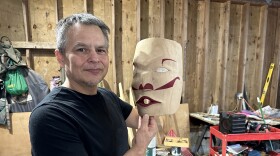Tree protection activists stood silently at the back of the Seattle City Council chambers on Tuesday. The city's urban canopy wasn't on the meeting agenda so the group conveyed its message with signs that read "Save Our Trees," "Put Climate Justice on the Agenda" and "Don't Clear Cut Seattle."
Organizers said they want to send a signal to city council that too many trees in Seattle’s urban forest are at risk because of housing developments. One tree in particular has become a flashpoint for this ongoing debate.
Several groups have rallied in recent weeks around a massive red cedar in the city’s Wedgwood neighborhood. It appears protected for now, after intervention by the Snoqualmie Tribe. But as a new tree ordinance takes effect this Sunday, July 30, the question looms of how Seattle will protect its largest and oldest trees.
On a recent morning in Wedgwood, birdcalls mixed with the sounds of construction. You could hear all kinds of songbirds —flickers and nuthatches, wrens, towhees and chickadees — near the cedar people are now calling Luma.
It towered above, on the edge of a lot that’s been cleared for six new housing units. Up high in its branches was a tree-sitter who had been there for days. She said her name is Droplet and that she was there on Wednesday when the Snoqualmie Tribe came through with a state archeologist.
“I got to look down and watch the Snoqualmie Tribe evaluate Luma and do ceremony. And it was the most incredible thing I've got to witness,” she said.
After the ceremony and site inspection, they concluded that Luma is a culturally modified tree, its limbs bent into a kind of living trail marker, likely pointing the way on a route connecting Lake Washington and Puget Sound.
“So instead of cutting down a tree and building a signpost, it was done in a way that allowed the tree to remain living and healthy,” said Jaime Martin, the executive director of governmental affairs and special projects for the Snoqualmie Tribe.
Under state law, the tree is now subject to protection as an archeological site. The developer, Legacy Group Capital, will need a permit from the state Department of Archeology and Historic Preservation before they can modify it.
The state said getting one will take at least 60 days, including 30 days for consultation with the tribe that registered the artifact. Legacy Group Capital did not respond to a request for comment.
Martin said the Snoqualmie Tribe asked the city to permanently withdraw its permit to remove the tree, but the city said it has no legal authority to revoke a permit once it is issued.

She said Seattle has no protections in place for culturally modified trees – not in its current tree ordinance and not in the new one.
”Basically, the city has a huge blind spot. And that's how to work with tribes and how to have meaningful consultation,” Martin said.
Both the city and the tribe have stated their desire to work to fix that. However, tree activists say the Wedgewood cedar is just one example of how Seattle is failing to protect its largest trees.
Numerous amendments proposed by the city’s appointed Urban Forestry Commission meant to address this and other concerns did not make it into the new tree ordinance. Calls for a better balance between the needs of developers and those of tree protectionists fell on deaf ears.
Despite assurances that fixes could be made before the new code takes effect, it appears nothing is in the works. And any future amendments will take months, if not years, to implement.
Councilmember Dan Strauss, who chairs Seattle’s Land Use Committee and presided over the update of the ordinance that passed in May, declined to be interviewed for this story. But he spoke at a council briefing earlier this month:
“At the final passage of the tree protection ordinance, I stated the desire to clean up and continue refining this ordinance. I still believe that today,” he said.
He said council will craft and pass a resolution outlining the scope and process for amendments. This will happen either in September or December, depending on the responsiveness of stakeholders.
In the meantime, the Snoqualmie Tribe has called on Mayor Bruce Harrell to use his executive power to delay enactment of the new tree ordinance.
Either way, activists will continue to push for improvements.







